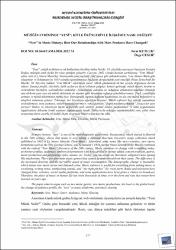| dc.contributor.author | Kutluk, Fırat | |
| dc.contributor.author | Cesur, Özge | |
| dc.date.accessioned | 2023-08-29T11:28:31Z | |
| dc.date.available | 2023-08-29T11:28:31Z | |
| dc.date.issued | 20.11.2022 | en_US |
| dc.identifier.citation | Kutluk, F. & Cesur, Ö. (2022). Müziğin Evriminde “YENİ”; Kitle Ürünleriyle İlişkimiz Nasıl Değişti? . Afyon Kocatepe Üniversitesi Akademik Müzik Araştırmaları Dergisi , CİLT VIII - ÖZEL SAYI , 337-347 . | en_US |
| dc.identifier.uri | https://dergipark.org.tr/tr/pub/amader/issue/74848/1169533 | |
| dc.identifier.uri | https://hdl.handle.net/11630/10355 | |
| dc.description.abstract | “Yeni”, müzik tarihinin en sık kullanılan sözcüklerinden biridir. 14. yüzyılda yeşermeye başlayan Yeniden Doğuş, müziğin artık farklı bir yöne gittiğini gösterir. Caccini, 1602 yılında basılan şarkılarına “Yeni Müzik” adını verir (Le Nuove Musiche). Sonrasında yeni reçitatif, yeni opera gibi adlandırmalar, Yeni Alman Okulu gibi oluşumlar ve Schumann’ın 1834 yılında yayımlanmaya başlayan dergisindeki yeni sözcüğü (Neue Zeitschrift für Musik), 20. Yüzyılın radikal “Yeni Müzik” söylemiyle sürer. Müzik günümüzde de her şeyiyle değişmeye devam ediyor. Sanatçı profili, izlerkitle, delik açılan ya da tel eklenen çalgılar, konser geleneği, müzik türleri, üretim ve seslendirme biçimleri, seslendirilen mekanlar…Günümüzde adından ne olduğunu anlamanın mümkün olmadığı ana türlerin yanı sıra alt müzik türlerinin de mantar gibi türediğini rahatça görebiliyorsunuz. Fark, çeşitliliğin artması ve müzik tüketiminin müthiş hızı. Demografik yapının değişimi kaçınılmaz, bu da yeni müzik beğenileri ve talepleri anlamına geliyor. Teknoloji, her boyutuyla ağırlığını koyuyor. Müzik software’leri müziği yapmaktan seslendirmeye, nota yazmaya, sesleri sentetikleştirmeye, vokal partları “doğru notalara çekmeye”, kısaca her şeye yarıyor! Radyo ve televizyon biçim değiştirdi, web siteleri, sosyal medya platformları ve kimi uygulamalar (application) dileyene kendi yayınını yapma şansı tanıdı. Dolayısıyla müziğin yaşamımızdaki yeri, yıllar önce araştırmacıların ısrarla söylediği biçim ve oranın binlerce kat üzerine çıktı. | en_US |
| dc.description.abstract | In music history, “new” is one of the most frequently used words. Renaissance, which started to flourish in the 14th century, shows that music is now taking a different direction. Caccini’s songs collection which published in 1602 is Le Nuove Musiche (New Music). Afterward, some terms like new recitative, new opera, formations such as the New German School, and Schumann’s 1834 journal (Neue Zeitschrift für Musik) continued with the radical “New Music” discourse of the 20th century. Music continues to change with everything today; performer profiles, audiences, timbres of instruments with holes drilled or strings added, concert tradition, genres, music production and performing styles, venues, etc. Today, you can easily see that music subgenres have sprung like mushrooms. There are also main music genres that cannot be understood from their name. The difference is the increased diversity and the incredible speed of music consumption. The demographic change is inevitable, which means new music tastes and demands arise. Music software is useful for everything from making music to vocalizing, writing notes, synthesizing sounds, and “the right pitches” for vocal parts. Radio and television have changed form, websites, social media platforms, and some applications have been given a chance to broadcast. Therefore, the place of music in human life has risen thousands of times over the form and rate that researchers insisted on years ago. | en_US |
| dc.language.iso | tur | en_US |
| dc.publisher | Afyon Kocatepe Üniversitesi | en_US |
| dc.identifier.doi | 10.36442/AMADER.2022.74 | en_US |
| dc.rights | info:eu-repo/semantics/openAccess | en_US |
| dc.subject | Yeni | en_US |
| dc.subject | Müzik Türü | en_US |
| dc.subject | İzlerkitle | en_US |
| dc.subject | Müzik Paylaşımı | en_US |
| dc.subject | New | en_US |
| dc.subject | Music Genre | en_US |
| dc.subject | Audience | en_US |
| dc.subject | Music Sharing | en_US |
| dc.title | Müziğin evriminde “yeni”; Kitle ürünleriyle ilişkimiz nasıl değişti? | en_US |
| dc.title.alternative | “New” in music history; How our relationships with mass products have changed? | en_US |
| dc.type | article | en_US |
| dc.relation.journal | Afyon Kocatepe Üniversitesi Akademik Müzik Araştırmaları Dergisi | en_US |
| dc.department | Afyon Kocatepe Üniversitesi | en_US |
| dc.authorid | 0000-0001-5412-8569 | en_US |
| dc.authorid | 0000-0003-4146-3020 | en_US |
| dc.identifier.volume | 8 | en_US |
| dc.identifier.startpage | 337 | en_US |
| dc.identifier.endpage | 347 | en_US |
| dc.identifier.issue | Özel Sayı | en_US |
| dc.relation.publicationcategory | Makale - Ulusal Hakemli Dergi - Başka Kurum Yazarı | en_US |



















